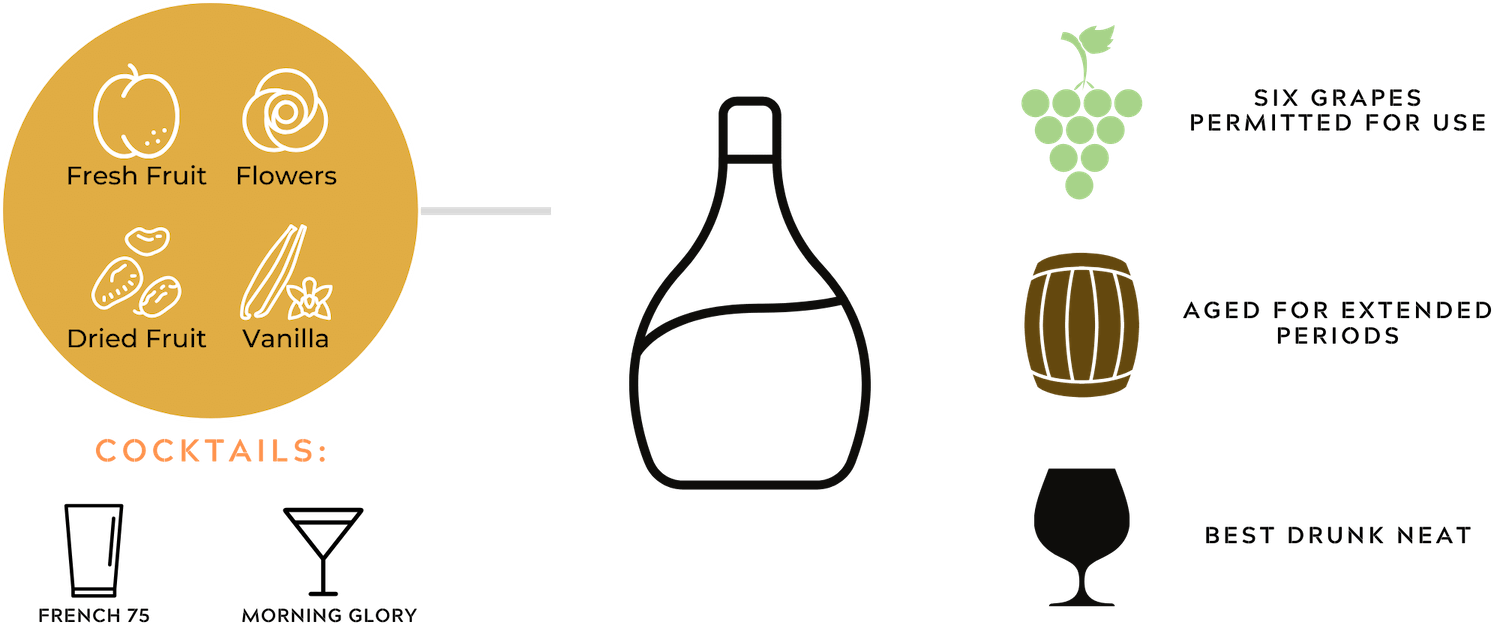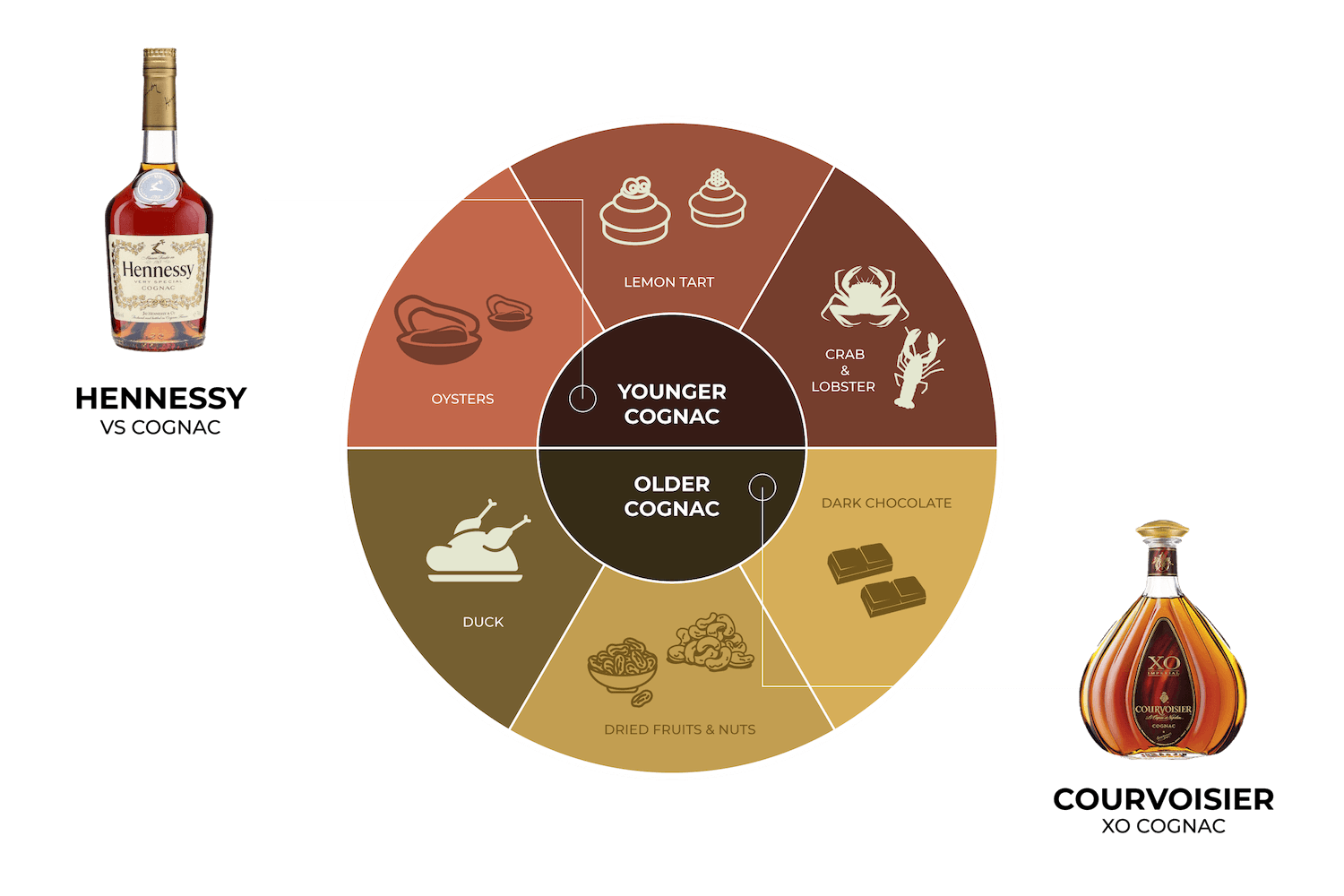Cognac is a form of distilled grape brandy produced exclusively within the Charente and Charente-Maritime departments in South West France, just North of the famed Bordeaux region.
Much like Scotch whisky, it has a number of strictly enforced rules and classifications that must be followed by its producers.
One of the most important rules includes that Cognac can only be produced using a select number of grapes, most commonly the ugni blanc, but also the folle blanche or colombard grapes.
These grapes, once harvested and pressed, undergo fermentation, with the resulting wine being low in sweetness, very dry, high in acidity and tartness, and only around 7-10% in alcohol, thus preserving the desired fruity and floral tastes found in the final product.
Cognac producers are bound to use only a traditional style copper pot still, called a Charentais copper still, and follow a process of double-distillation, which must be completed by the 31st March under French law.
Before the resulting clear spirit begins ageing it is called eau de vie, which is very high in alcohol at around 70%, and has strong peach and fruit-like flavours.
Prior to these being blended and placed into a bottle to be called Cognac, the separate eau de vie distillates have to be aged for at least two years in oak barrels, a process that aids in the colouring of the spirit as well as imparting flavours of caramel, spice, leather, and toffee.
After blending with other aged eau de vie, the resulting spirit is cut with water to reduce its alcohol content and distillers are allowed to add caramel colouring and sugar prior to bottling to affect its colour and taste.
Once blended and bottled, the final product can be called Cognac, although there are important distinctions made between each bottle that helps us to understand the expected quality and age of the liquid in the bottle.
For an additional explanation on some of the important rules to consider when exploring the category, read this article.
The basic process of Cognac having been laid out, there are a number of classifications that are displayed on the bottles sold that allude to the quality and taste of the spirit within, detailed below.
The classifications provided above are protected under French law and help producers distinguish their Cognacs apart from other brandies and their competitors.
When looking for Cognacs of a higher quality, be sure to look for those which have been aged longer, as only the finest eau de vies are selected and reserved for such lengthy periods of ageing.
It's also important to note that because Cognacs are a blend of various individual eau de vie, the youngest spirit used in the blend must reach the minimum ageing requirement, meaning it is possible to have blends of younger and much older eau de vie together in a single bottle.
The Cognac market is overwhelmingly dominated by four major brands, which are Hennessy, Martell, Rémy Martin, and Courvoisier, who are responsible for producing over 90% of Cognacs sold.
The vineyards that these and all other brands source their Cognac producing grapes from are all from a particular region in South West France, which is broken up into six distinct sub-regions, identified below.
Whilst these four dominate the market, there are more than 300 smaller brands that sell Cognacs produced from grapes often grown from their own family owned vineyards, although these products are often hard to find outside of France.
This site showcases some of the rarer Cognac-producing distilleries and producers available today.
Looking at the four major Cognac producers, each of them produce bottles made in their own particular house style, so it is worth considering the tasting notes of each bottle before purchasing.
For those looking to begin their tasting journey, it is recommended that you start with the Courvoisier V.S. Cognac, as this is an example of one of the sweetest and therefore more approachable Cognacs, whilst bottles such as Martell V.S. Cognac and Remy Martin X.O. Cognac are drier, more balanced, and far more complex.
Although Cognac may be similar in definition to other grape or fruit brandies, it has a remarkably different and unique taste profile due, in part, to the strict rules regulating its production.
When looking at what flavours and sensations you should expect when trying Cognac, there are a number of common flavours used to describe the tasting experience by the experts.
One can expect of almost any Cognac, regardless of age, to contain flavours of vine flowers, fresh fruits, sweet spices, such as vanilla and cinnamon, dried fruits, such as apricots or peaches, and candied fruits.
Beyond these, Cognac can develop flavours of chocolate, leather, Port or Sherry wine, toffee, and exotic spice the longer it is aged, explaining why well-aged Cognacs are so prized.
When looking to consume Cognac, it is recommended that you enjoy it as a digestif after a meal and neat without ice, especially in the case of those that are well aged, such as many V.S.O.P. and X.O. varieties.
The reason for this is that thoroughly aged Cognacs have extreme depths of flavour and character that can easily be ruined by combining the spirit with water or a mixer and so it is advised that when making cocktails, you stick to choosing bottles of V.S. Cognac.
Common cocktail choices include the sidecar, which can also often be made with Armagnac, French 75, which combines Champagne with Cognac, and even a Hennessy V.S. and green tea mix, which, though simple, is refreshingly easy to make and consume.
Although it is not often thought of for people to pair food with spirits, there are some fantastic food pairing options available when looking to match premium French Cognac with food.
Generally speaking, the incredibly nuanced and delicate blend of flavours in Cognacs of dried and fresh fruits, sweet spices, and candied fruits can be sublimely paired with common finger foods, such as dark chocolate or dried fruits and nuts, as well as main dishes, including roasted or spiced duck with orange sauce.
For more interesting food pairing options consider matching Cognac with creamy or soft blue cheeses, or chilling the bottle of Cognac you have and serving it alongside seafood dishes, such as oysters, crab or lobster.
There's a bottle of Cognac out there for everyone. Here are some of the brands and bottles that we recommend you look out for the next time you're browsing online or in-store.
Looking to explore the wonderful world of Australian Brandy? Start here with our quick guide into the best brands to try & how to serve them.
Are you interested in Cognac & Armagnac but don’t know where to find them? We’ve done the research & bring you the best places to buy & try them in Sydney!
Looking to spruce up your mixing game? We’ve put together a quick guide on which of the common supermarket mixers work best with some of your favourite spirits.



